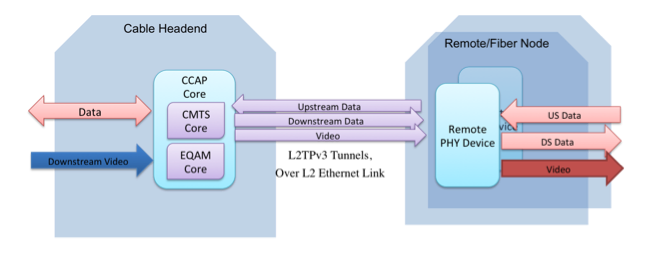DOCSIS
CableLabs® New Remote PHY Specifications expand DOCSIS® Network deployment options

DOCSIS technology continues to extend the usefulness of the hybrid fiber coaxial network and increase its global adoption. Distributed Architectures for DOCSIS networks are emerging that provide significant scale advantages and flexible deployment options supporting for both DOCSIS 3.0 and DOCSIS 3.1 networks. Distributed DOCSIS deployments are beginning today in some markets based on the earlier C-DOCSIS specifications.
New Specification Release
CableLabs is documenting several different Distributed CCAP Architectures (including Remote PHY and Remote MAC-PHY) and will release the set of technical reports and specifications throughout this summer.
Last month, CableLabs publicly issued the Remote PHY family of specifications. Theses specifications are also known as MHAv2 as these are an evolution from the original Modular Headend Architecture specifications.
The Remote PHY technology allows for an integrated CCAP to be separated into two components: the CCAP Core and the Remote PHY Device (RPD) and describes the interfaces between them. One of the common locations for an RPD is the optical node device that is located at the junction of the fiber and coax plants, while the CCAP Core stays at the headend. A CCAP core can control and setup data paths with multiple RPDs situated in multiple fiber nodes.
What is Remote PHY?
The Remote PHY technology uses pseudowires between a CCAP Core and a set of RPDs. The CCAP Core contains both a CMTS Core for supporting DOCSIS data transport and an Edge QAM Core for supporting video transport. The CMTS Core contains the DOCSIS MAC (signaling functions, downstream and upstream bandwidth scheduling, and DOCSIS framing) and the upper layer protocols. Remote PHY supports both DOCSIS 3.0 & 3.1 Specifications. The EQAM Core contains all the video processing functions that an EQAM provides today.
The RPD contains mainly PHY related circuitry, such as downstream QAM and OFDM modulators, upstream QAM and OFDM demodulators, together with pseudowire logic needed to connect to the CCAP Core. The RPD platform is a physical layer converter device whose functions are to convert downstream DOCSIS data, MPEG video and out-of-band (OOB) signals received from a CCAP Core over a digital fiber network such as Ethernet or passive optical network (PON) to analog RF for transmission over the coaxial cable; and to convert upstream RF DOCSIS, and OOB signals received over the coaxial cable to digital for transmission over Ethernet or PON to a CCAP Core.
The CableLabs Remote PHY technology is detailed by six specifications and one technical report (describing the overall architecture) including:
- The System Specification that describes System level requirements such as initialization sequences and security.
- The R-DEPI and R-UEPI specifications that describe the downstream and upstream pseudowires and the L2TPv3 control plane.
- The GCP specification that defines a protocol used for configuration of Remote PHY Devices (RPD).
- The R-DTI specification that defines the timing interface between the CCAP-Core and RPD.
- The R-OOB specification that defines support for the SCTE55-1 and 55-2 out of band data for video applications.
What’s Next?
These specifications define the technology to provide guidance to vendors building solutions for the Remote PHY architecture. Vendors have begun architecting ASIC designs, device platforms and software to implement the RPD and CCAP-Core devices. The OSS requirements for managing these devices are also being specified at CableLabs and will be released as an additional specification later this summer. These distributed architectures of course support standard DOCSIS 3.0 and 3.1 modems and gateways no differently than integrated architectures.
The main options under the umbrella of Distributed CCAP Architectures are the Remote PHY and the Remote MAC-PHY technologies. CableLabs’ work is in progress to document the Remote MAC-PHY architecture. This work will culminate in a technical report which will also be released this summer.
Investigating Distributed CCAP Architectures
The work around Distributed CCAP architectures (DCA) is of interest to many CableLabs members in North America, Europe and Asia. Cable operators are investigating DCA for the various gains they bring including:
- Maximizing DOCSIS 3.1 Channel capacity
- Simpler operations with digital fiber/Ethernet transport
- Higher Efficiency of Digital Optics vs. Analog Optics (wavelengths, reach, cost)
- Helps hub/headend facilities issues around space, power, and cooling as operators move towards Fiber Deep architectures or consider further Node Splits
- Consistency with FTTx deployments which will include remote architectures for reach and wavelength management
- Fits with the SDN/NFV initiatives operators are considering across access networks
These integrated & distributed HFC technologies have parallels, and similar features and benefits, to wireless infrastructure architectures such as Macro-cells, small-cells, Distributed Antenna Solutions, and Cloud-RAN with Remote Radio Units. These Distributed CCAP Architectures fit well in different deployment scenarios and all work cohesively together to support the varying capacity and demand in the areas where their deployments provide the best solution.
As operators look to optimize their network deployments in each of their cable plants in each of their markets it will be very interesting to see how and where these distributed CCAP technologies will be deployed in each operator’s HFC networks. It is indeed an exciting time to be working on the access network technologies and being part of the evolution it is going through.
Karthik Sundaresan is a Principal Architect at CableLabs, responsible for the development and architecture of cable access network technologies. He is primarily involved in the DOCSIS family of technologies and their continued evolution.



